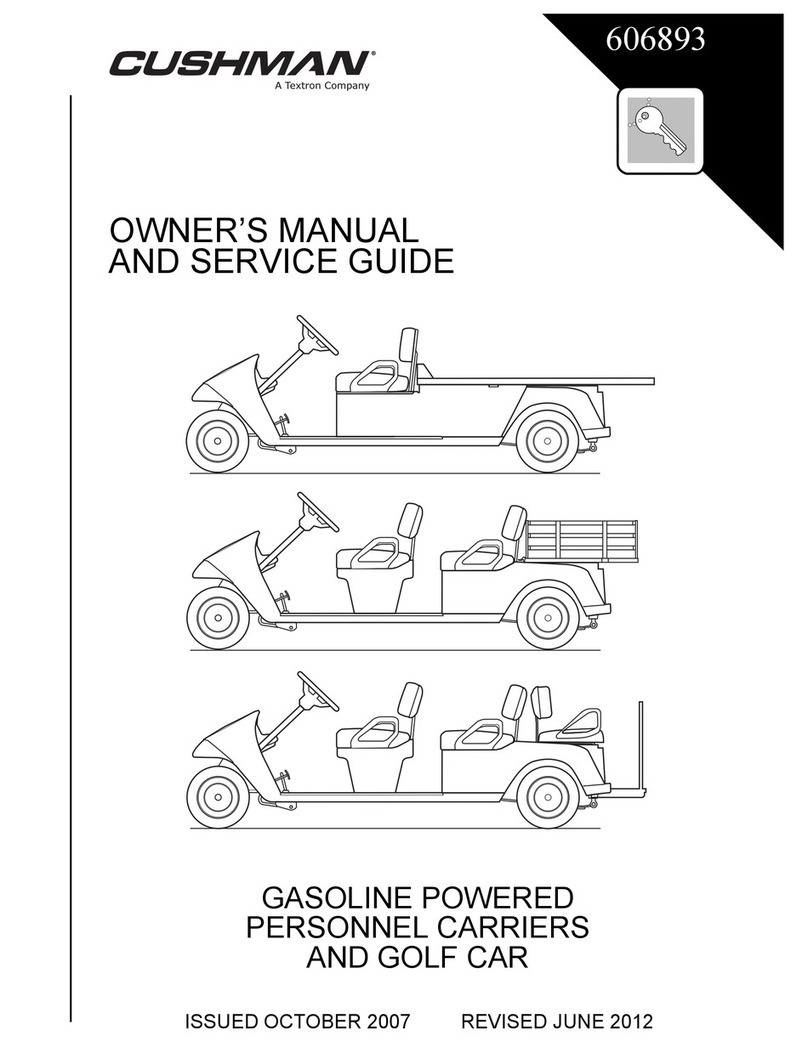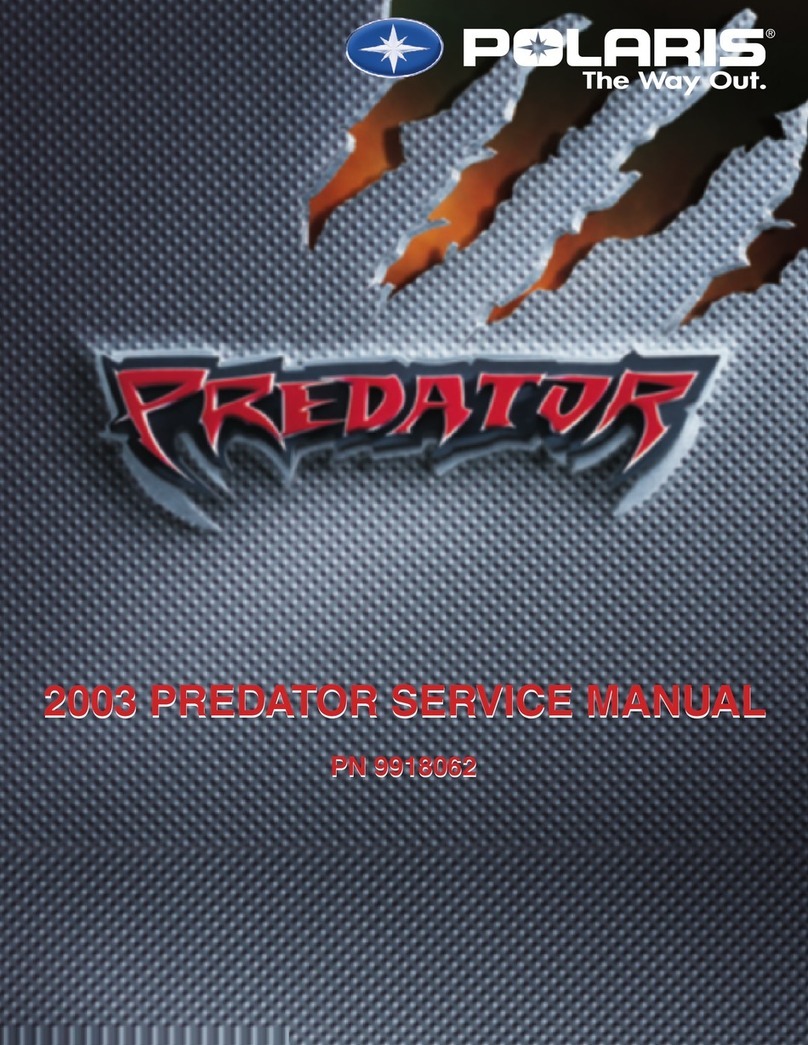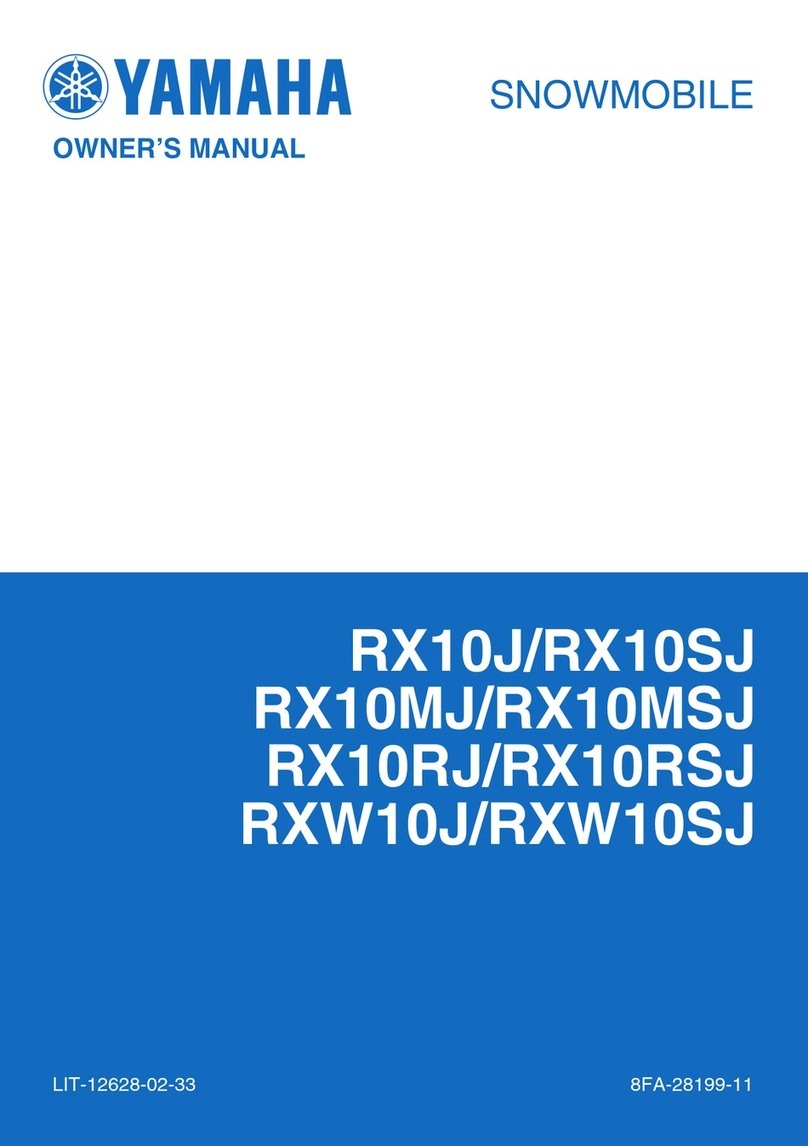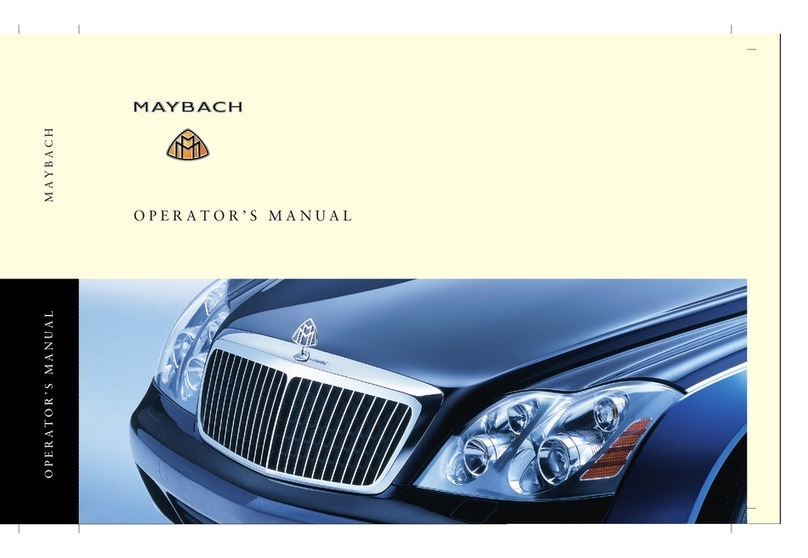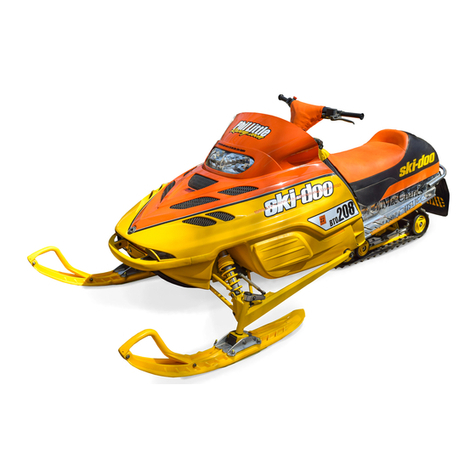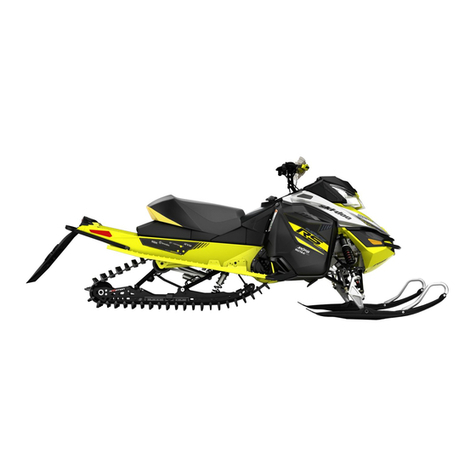Textron ALTERRA 500 2018 User manual


Your ATV can be hazardous to operate.
A collision or rollover can occur quickly, even during routine maneuvers such as
turning and driving on hills or over obstacles, if you fail to take proper precautions.
For your safety, it is important to understand and follow all of the warnings contained
in this Operator’s Manual and the labels on your ATV prior to riding.
Keep this Operator’s Manual with your ATV at all times. This Operator’s Manual
should be considered a permanent part of the vehicle and must remain with the vehi-
cle at the time of resale. If the ATV changes ownership more than once, contact Tex-
tron Off Road, Service Department, P.O. Box 810, Thief River Falls, MN 56701, for
proper registration information.
Labels should be considered as permanent parts of the vehicle. If a label comes off or
becomes hard to read, contact your authorized dealer for a replacement.
FAILURE TO FOLLOW THE WARNINGS CONTAINED IN THIS MANUAL
CAN RESULT IN SERIOUS INJURY OR DEATH.
For your safety, it is important all operators be properly trained to operate an ATV.
Training is available: U.S. owners, call 800-887-2887; Canadian owners, call 613-
739-1535.
Pour votre sécurité, il est importante que tout opérateur est formé correctement pour
opérer un VTT. Un cours d’instruction est disponible: pour les propriétaires cana-
diens, composez le 613-739-1535.
Particularly important information is distinguished in this manual by the following
notations:
California Proposition 65
!The Safety Alert Symbol means ATTENTION! BE
ALERT! YOUR SAFETY IS INVOLVED.
! WARNING WARNING indicates a hazardous situation which, if not
avoided, could result in death or serious injury.
CAUTION CAUTION, without the safety alert symbol, is used to
address practices not related to personal injury.
NOTE: A NOTE provides key information to make procedures
easier or more clear.
! WARNING
This product contains or emits chemicals known to the State of California to
cause cancer and birth defects or other reproductive harm.

Foreword
Congratulations and thank you for pur-
chasing a a Textron Off Road All-Terrain
Vehicle (ATV). Built with American
engineering and manufacturing know-
how, it is designed to provide superior
ride, comfort, utility, and dependable ser-
vice.
This Operator’s Manual is furnished to
ensure that the operator is aware of safe
operating procedures. It also includes
information about the general care and
maintenance of your ATV.
Carefully read the following pages. If
you have any questions regarding this
ATV, contact an authorized Textron Off
Road dealer (hereinafter “authorized
dealer(s)”) for assistance. Remember,
only authorized dealers have the knowl-
edge and facilities to provide you with
the best service possible.
• Know all local, state/provincial riding
laws,
• Respect your ATV,
• Respect the environment, and
• You will gain the respect of others.
We also advise you to strictly follow the
recommended maintenance program as
outlined. This preventive maintenance
program is designed to ensure that all
critical components on this ATV are thor-
oughly inspected at various intervals.
All information in this manual is based
on the latest product data and specifica-
tions available at the time of printing. We
reserve the right to make product changes
and improvements which may affect
illustrations or explanations without
notice.
Division II of this manual covers opera-
tor-related maintenance, operating
instructions, and storage instructions. If
major repair or service is ever required,
contact an authorized dealer for profes-
sional service.
At the time of publication, all informa-
tion and illustrations in this manual were
technically correct. Some illustrations
used in this manual are used for clarity
purposes only and are not designed to
depict actual conditions. Because we
constantly refine and improve our prod-
ucts, no retroactive obligation is incurred.
Textron Specialized Vehicles, Inc. and
the ATV Safety Institute recommend that
all ATV operators ride the appropriate-
sized ATV according to age.
Protect Your Sport
Parts and Accessories
When in need of replacement parts, oil,
or accessories for your ATV, be sure to
use only GENUINE PARTS, OIL,
AND ACCESSORIES. Only genuine
parts, oil, and accessories are engi-
neered to meet the standards and
requirements of your ATV. For a
complete list of accessories, refer to
the current ATV/ROV Accessory
Catalog.
To aid in service and maintenance pro-
cedures on this ATV, a Service Manual
is available through your local autho-
rized dealer.
Category Age
(Years)
Speed
Limitations
(MPH)
NOTES
Y-12+ 12 or
Older
15 - Limited
30 - Maximum
Operate
Under Adult
Supervision
T-14 14 or
Older
20 - Limited
30 - Limited
38 - Maximum
Operate
Under Adult
Supervision
G & S 16 or
Older
According to
Local Regula-
tions
—

Table of Contents
Foreword .................................................. 1
Parts and Accessories............................ 1
Division I - Safety
ATV Safety Alert ...................................... 4
Rider Training Course ............................. 5
Hangtags .................................................. 6
Warning Labels & Information ............ 7-8
Warnings ............................................. 9-17
Prevention......................................... 18-21
Safe Riding Clothing and Gear ............ 18
Condition of the ATV ............................ 19
First Aid and Survival ........................... 20
Active Riding ......................................... 22
Sound Judgment .............................. 23-26
Environment ......................................... 23
Those Around You................................ 24
Equipment ............................................ 24
Load Capacity Ratings Chart ............... 25
Personal Choices ................................. 25
Supervision............................................ 27
Taking Responsibility............................ 27
Inexperienced/Untrained Riders......... 27
Experienced/Trained Riders ............... 27
Division II - Operation/
Maintenance
ATV Specifications ................................ 28
Location of Parts and Controls ............ 29
ATV Operation .................................. 30-38
Basic Operating Maneuvers................. 30
Mounting the ATV............................... 30
Starting the Engine ............................ 30
Starting a Cold Engine ....................... 30
Braking/Stopping................................ 30
Shifting ............................................... 31
Parking ............................................... 31
Dismounting the ATV.......................... 31
How to Handle the ATV (Active Riding
Techniques)....................................... 32
Tips ...................................................... 37
General Information ......................... 39-46
Control Locations and Functions.......... 39
Speedometer/LCD Gauge (Digital) ...... 41
Oil Level Stick....................................... 43
Seat Latch ............................................ 43
Safety Flag Bracket .............................. 43
Rack Loading (Front and Rear)............ 44
Trailering and Towing............................ 44
Transporting ATV.................................. 44
Gasoline-Oil-Lubricant ......................... 45
Engine Break-In ................................... 46
Burnishing Brake Pads......................... 46
General Maintenance ....................... 47-59
Maintenance Schedule......................... 47
Liquid Cooling System ......................... 48
Shock Absorbers .................................. 48
General Lubrication.............................. 49
Hydraulic Hand Brake .......................... 51
Brake Fluid ......................................... 51
Brake Lever Lock................................ 51
Brake Hoses....................................... 51
Brake Pads.......................................... 51
Rear Foot Brake ................................... 51
Protective Rubber Boots ...................... 52
Battery.................................................. 53
Spark Plug............................................ 55
Throttle Cable Adjustment.................... 55
Air Filter................................................ 56
Air Filter Housing Drain ........................ 56
Draining V-Belt Cover ........................... 57
Tires ..................................................... 57
Wheels ................................................. 57
Muffler/Spark Arrester .......................... 58
Light Bulb Replacement ....................... 58
Checking/Adjusting Headlight Aim ....... 59
Fuses ................................................... 59
Tools..................................................... 59
Preparation for Storage ........................ 60
Preparation after Storage ..................... 61
Limited Warranty ................................... 62
Warranty Procedure/Owner
Responsibility.................................... 63
U.S. EPA Emission Control Statement/
Warranty Coverage (U.S. Only) ........ 64
Change of Address, Ownership, or
Warranty Transfer .............................. 65
Maintenance Record ........................ 67-68
Identification Numbers Record ......Inside
Back Cover

! WARNING Indicates a hazardous situation which, if not
avoided, could result in death or serious injury. 3
Division I - Safety
An ATV is not a toy and
can be hazardous to
operate.
• Always go slowly and be extra careful
when operating on unfamiliar terrain.
Always be alert to changing terrain condi-
tions when operating the ATV.
• Never operate on excessively rough, slip-
pery, or loose terrain.
• Always follow proper procedures for turn-
ing as described in this manual. Practice
turning at slow speeds before attempting
to turn at faster speeds. Do not turn at
excessive speed.
• Always have the ATV checked by an
authorized ATV dealer if it has been
involved in an accident.
• Never operate the ATV on hills too steep
for the ATV or for your abilities. Practice
on smaller hills before attempting larger
hills.
• Always follow proper procedures for
climbing hills as described in this man-
ual. Check the terrain carefully before
you start up any hill. Never climb hills
with slippery or loose surfaces. Shift your
weight forward. Never open the throttle
suddenly or make sudden gear changes.
Never go over the top of any hill at high
speed.
• Always follow proper procedures for
going down hills and for braking on hills
as described in this manual. Check the
terrain carefully before you start down
any hill. Shift your weight backward.
Never go down a hill at high speed. Avoid
going down a hill at an angle which would
cause the ATV to lean sharply to one
side. Go straight down the hill where pos-
sible.
• Always be sure there are no obstacles or
people behind you when you operate in
reverse. When it is safe to proceed in
reverse, go slowly. Avoid turning at sharp
angles in reverse.
• Always follow proper procedures for
crossing the side of a hill as described in
this manual. Avoid hills with slippery or
loose surfaces. Shift your weight to the
uphill side of the ATV. Never attempt to
turn the ATV around on any hill until you
have mastered the turning techniques
described in this manual on level ground.
Avoid crossing the side of a steep hill if
possible.
• Always use proper procedures if you stall
or roll backward when climbing a hill. To
avoid stalling, maintain a steady speed
when climbing a hill. If you stall or roll
backwards, follow the special procedure
for braking described in this manual. Dis-
mount on the uphill side or to either side
if pointed straight uphill. Turn the ATV
around and mount following the proce-
dure described in this manual.
• Always check for obstacles before oper-
ating in a new area. Never attempt to
operate over large obstacles, such as
large rocks or fallen trees. Always follow
proper procedures when operating over
obstacles as described in this manual.
• Always be careful of skidding or sliding.
On slippery surfaces, such as ice, go
slowly and be very cautious in order to
reduce the chance of skidding or sliding
out of control.
• Never operate an ATV in fast flowing
water or in water deeper than the foot-
rests. Remember that wet brakes may
have reduced stopping capability. Test
your brakes after leaving water. If neces-
sary, apply them lightly several times to
let friction dry out the pads.
• Always use the size and type tires speci-
fied in this manual. Always maintain
proper tire pressure as described in this
manual.
• Never improperly install or improperly
use accessories on this ATV.
• Never install a twist grip throttle on this
AT V.
• Never exceed the stated load capacity for
an ATV. Cargo should be properly distrib-
uted and securely attached. Reduce
speed and follow instructions in this man-
ual for carrying cargo or pulling a trailer
and allow greater distance for braking.
• No one under the age of 16 should oper-
ate this ATV. Some operators at the age
of 16 may not be able to operate an ATV
safely. Parents should supervise the use
of the ATV at all times. Parents should
permit continued use only if they deter-
mine that the operator has the ability to
operate the ATV safely.
FOR MORE INFORMATION
ABOUT ATV SAFETY, call the ATV
Safety Institute at 1-800-887-2887
(U.S.) or 1-613-739-1535 (Canada).

! WARNING Indicates a hazardous situation which, if not
avoided, could result in death or serious injury.
4
ATV Safety Alert
The Consumer Product Safety Commis-
sion has concluded that ALL-TERRAIN
VEHICLES (ATVs) may present a risk of
SERIOUS INJURY or DEATH in certain
circumstances. Accidents may occur for
many reasons:
Over 2041 people, including many chil-
dren, have died in accidents associ-
ated with ATVs since 2011.
Many people have become severely para-
lyzed or suffered serious internal
injuries as a result of accidents asso-
ciated with ATVs.
Every month thousands of people are
treated in hospital emergency rooms
for injuries received while riding an
ATV.
You should be aware that AN ATV IS
NOT A TOY AND CAN BE HAZARD-
OUS TO OPERATE. An ATV handles
differently from other vehicles, including
motorcycles and cars. A collision or roll-
over can occur quickly, even during rou-
tine maneuvers such as turning and
driving on hills and over obstacles, if you
fail to take proper precautions.
TO AVOID SERIOUS
INJURY OR DEATH:
Always read the Operator’s Manual care-
fully and follow the operating proce-
dures described. Pay special attention
to the warnings contained in the man-
ual and on all labels.
Never operate an ATV without proper
instruction. Take a training course.
Beginners should complete a training
course.
Always follow these age recommenda-
tions:
• A Y-12+ is intended for use by children
age 12 or older, and a T-14 is intended
for use by an operator age 14 or older.
• A child under 16 years old should never
operate an ATV without adult supervi-
sion. Children need to be observed
carefully because not all children have
the strength, size, skills, or judgment to
operate an ATV safely.
Never carry a passenger on an ATV. Car-
rying a passenger may upset the bal-
ance of the ATV and may result in
loss of control.
Always avoid paved surfaces. ATVs are
not designed to be used on paved sur-
faces and may seriously affect han-
dling and control.
Never operate an ATV on a public road,
even a dirt or gravel one, because you
may not be able to avoid colliding
with other vehicles. Also, operating
an ATV on a public road may be
against the law.
Never operate an ATV without an
approved motorcycle helmet, eye
protection, boots, gloves, long pants,
and a long-sleeved shirt or jacket.
Never consume alcohol or drugs before or
while operating an ATV.
Never operate an ATV at excessive
speeds. Go at a speed which is proper
for the terrain, visibility conditions,
and your experience.
Never attempt to do wheelies, jumps, or
other stunts.
Always be careful when operating an
ATV, especially when approaching
hills, turns, and obstacles and when
operating on unfamiliar or rough ter-
rain.
Never lend an ATV to anyone who has not
taken a training course or has not
been driving an ATV for at least a
year.

! WARNING Indicates a hazardous situation which, if not
avoided, could result in death or serious injury. 5
Rider Training Course
The Textron Specialized Vehicles divi-
sion of Textron, Inc. (hereinafter “the
manufacturer”) sponsors a free Rider
Training Course to teach ATV riding
skills or to reinforce current riding skills.
First-time purchasers without any previ-
ous ATV riding experience will receive a
$100.00 coupon from the manufacturer
through the SVIA/ASI after completing
the training course (U.S. owners only,
one incentive, and free rider training
courses for appropriate immediate family
members per ATV purchase). See an
authorized dealer for details or call (800)
887-2887 for training course information.
In Canada, the Canada Safety Council
(CSC) provides an ATV Rider’s Course
to teach safe ATV operating skills. They
also provide a special ATV Rider’s
Course for children under 14 years of age
with parental supervision. Call the CSC
at 1-613-739-1535 ext. 227 for more
details. Also available is a bilingual com-
puter-based safety training program on a
CD-ROM from CATV - call toll-free at
1-877-470-2288.
Au canada, le conseil canadien de la
sécurité (CSC) offre un cours de conduite
de VTT pour enseigner les habiletés
d’opération sécuritaires de VTT. Un
cours spécial de conduite de VTT est
également offert aux enfants de moins de
14 ans avec la surveillance d’un parent.
Communiquez avec le CSC en com-
posant le: 1-613-739-1535, poste 227
pour de plus amples informations. Un
programme de formation bilingue infor-
matisé sur la sécurité est aussi disponible
sur disque optique compact par CATV;
composez sans frais le: 1-877-470-2288.
FOR MORE INFORMATION
ABOUT ATV SAFETY, in the U.S.,
call the Consumer Product Safety
Commission at (800) 638-2772 or the
ATV Distibutors’ Safety Hotline at
(800) 852-5344 or in Canada, call the
Canada Safety Council at 1-613-739-
1535.
Visit the manufacturer’s website for addi-
tional product information.

! WARNING Indicates a hazardous situation which, if not
avoided, could result in death or serious injury.
6
Hangtags
This vehicle comes with hangtags containing important safety information. Anyone
who rides the vehicle should read and understand this information before riding.
2258-133

! WARNING Indicates a hazardous situation which, if not
avoided, could result in death or serious injury. 7
Warning Labels & Information
This vehicle comes with several labels containing important safety information. Any-
one who rides the vehicle should read and understand this information before riding.
The labels should be considered as permanent parts of the vehicle. If a label comes
off or becomes hard to read, contact your authorized dealer for a replacement.
NOTE: The location and content of labels on the ATV you have purchased
may differ from those shown on this page.
B
1411-804
6411-412
A
1411-077
E
1411-681
1411-577
H
I

! WARNING Indicates a hazardous situation which, if not
avoided, could result in death or serious injury.
8
Warning Labels & Information
Pour commander des Étiquettes de Mise en Garde gratuites, voyez votre concession-
naire agréé VTT pour le numéro de pièce 2436-559.
XR188B
XR184B
C
1411-932
F
1411-865
J
5411-998
G
1411-809
D
1411-682
K
0411-426

! WARNING Indicates a hazardous situation which, if not
avoided, could result in death or serious injury. 9
Warnings
! WARNING
POTENTIAL HAZARD
Operating this ATV without proper instruction.
WHAT CAN HAPPEN
The risk of an accident is greatly increased if the operator does not know how to
operate the ATV properly in different situations and on different types of terrain.
HOW TO AVOID THE HAZARD
Beginning and inexperienced operators should complete the certified training
course offered. They should then regularly practice the skills learned in the course
and the operating techniques described in this Operator’s Manual.
For more information about the training course, contact an authorized dealer or call
1-800-887-2887 (U.S.) or 1-613-739-1535 (Canada).
! WARNING
POTENTIAL HAZARD
Allowing anyone under age 16 to operate this ATV.
WHAT CAN HAPPEN
Use of an ATV by children can lead to serious injury or death of the child.
Children under the age of 16 may not have the skills, abilities, or judgment needed
to operate the ATV safely and may be involved in a serious accident.
HOW TO AVOID THE HAZARD
A child under 16 should never operate this ATV.
! WARNING
POTENTIAL HAZARD
Carrying a passenger on this ATV.
WHAT CAN HAPPEN
Greatly reduces your ability to balance and control
this ATV.
Could cause an accident, resulting in injury or death
to you and/or your passenger.
HOW TO AVOID THE HAZARD
Never carry a passenger. The long seat is to allow the operator to shift positions as
needed during operation. It is not for carrying passengers.

! WARNING Indicates a hazardous situation which, if not
avoided, could result in death or serious injury.
10
! WARNING
POTENTIAL HAZARD
Operating this ATV on paved surfaces.
WHAT CAN HAPPEN
The ATV’s tires are designed for off-road use only, not
for use on pavement. Paved surfaces may seriously
affect handling and control of the ATV and may cause
the ATV to go out of control.
HOW TO AVOID THE HAZARD
Whenever possible, avoid operating the ATV on any paved surfaces including side-
walks, driveways, parking lots, and streets. If operating on paved surfaces is
unavoidable, travel slowly (less than 10 MPH) and avoid sudden turns and stops.
! WARNING
POTENTIAL HAZARD
Operating this ATV on public streets, roads, or high-
ways.
WHAT CAN HAPPEN
You can collide with another vehicle.
HOW TO AVOID THE HAZARD
Never operate this ATV on any public street, road, or
highway, even a dirt or gravel one.
In many states it is illegal to operate an ATV on public streets, roads, or highways.
! WARNING
POTENTIAL HAZARD
Operating this ATV without wearing an approved hel-
met, eye protection, and protective clothing.
WHAT CAN HAPPEN
Operating without an approved helmet increases your
chances of a serious head injury or death in the event
of an accident.
Operating without eye protection can result in an acci-
dent and increases your chances of a serious injury in
the event of an accident.
Operating without protective clothing increases your
chances of serious injury in the event of an accident.
HOW TO AVOID THE HMAZARD
Always wear an approved helmet that fits properly.
You should also wear: Eye protection (goggles or
face shield)
Gloves
Boots
Long sleeved shirt or jacket
Long pants

! WARNING Indicates a hazardous situation which, if not
avoided, could result in death or serious injury. 11
! WARNING
POTENTIAL HAZARD
Going down a hill improperly.
WHAT CAN HAPPEN
Could cause loss of control or cause the ATV to over-
turn.
HOW TO AVOID THE HAZARD
Always follow proper procedures for going down hills
as described in this Operator’s Manual.
Always check the terrain carefully before you start down any hill.
Shift your weight backward.
Never go down a hill at high speed.
Avoid going down a hill at an angle that would cause the ATV to lean sharply to
one side. Go straight down the hill where possible.
! WARNING
POTENTIAL HAZARD
Operating this ATV after or while consuming alcohol or drugs.
WHAT CAN HAPPEN
Could seriously affect your judgment.
Could cause you to react more slowly.
Could affect your balance and perception.
Could result in an accident.
HOW TO AVOID THE HAZARD
Never consume alcohol or drugs before or while driving this ATV.
! WARNING
POTENTIAL HAZARD
Operating this ATV at excessive speeds.
WHAT CAN HAPPEN
Increases your chances of losing control of the ATV, which can result in an acci-
dent.
HOW TO AVOID THE HAZARD
Always ride at a speed that is proper for the terrain, visibility and operating condi-
tions, and your experience.

! WARNING Indicates a hazardous situation which, if not
avoided, could result in death or serious injury.
12
! WARNING
POTENTIAL HAZARD
Attempting wheelies, jumps, and other stunts.
WHAT CAN HAPPEN
Increases the chance of an accident including a roll-
over.
HOW TO AVOID THE HAZARD
Never attempt stunts, such as wheelies or jumps.
Don’t try to show off.
! WARNING
POTENTIAL HAZARD
Failure to inspect the ATV before operating.
Failure to properly maintain the ATV.
WHAT CAN HAPPEN
Increases the possibility of an accident or equipment damage.
HOW TO AVOID THE HAZARD
Always inspect your ATV each time you use it to make sure the ATV is in safe oper-
ating condition.
Always follow the inspection and maintenance procedures and schedules
described in this Operator’s Manual.
! WARNING
POTENTIAL HAZARD
Removing hands from handlebars or feet from footrests during operation.
WHAT CAN HAPPEN
Removing even one hand or foot can reduce your ability to control the ATV or could
cause you to lose your balance and fall off the ATV. If you remove a foot from a
footrest, your foot or leg may come into contact with the wheels, which could injure
you or cause an accident.
HOW TO AVOID THE HAZARD
Always keep both hands on the handlebars and both feet on the footrests of your
ATV during operation.

! WARNING Indicates a hazardous situation which, if not
avoided, could result in death or serious injury. 13
! WARNING
POTENTIAL HAZARD
Failure to use extra care when operating the ATV on
unfamiliar terrain.
WHAT CAN HAPPEN
You can come upon hidden rocks, bumps, or holes
without enough time to react.
Could result in the ATV overturning or going out of
control.
HOW TO AVOID THE HAZARD
Go slowly and be extra careful when operating on unfamiliar terrain.
Always be alert to changing terrain conditions when operating the ATV.
! WARNING
POTENTIAL HAZARD
Failure to use extra care when operating on rough,
slippery, or loose terrain.
WHAT CAN HAPPEN
Could cause loss of traction or control of the ATV
which could result in an accident including a rollover.
HOW TO AVOID THE HAZARD
Do not operate on rough, slippery, or loose terrain
until you have learned and practiced the skills necessary to control the ATV on
such terrain.
Always be especially cautious on these kinds of terrain.
! WARNING
POTENTIAL HAZARD
Turning improperly.
WHAT CAN HAPPEN
ATV could go out of control, causing a collision or rollover.
HOW TO AVOID THE HAZARD
Always follow proper procedures for turning as described in this Operator’s Man-
ual.
Practice turning at slow speeds before attempting to turn at faster speeds.
Do not turn at excessive speed.

! WARNING Indicates a hazardous situation which, if not
avoided, could result in death or serious injury.
14
! WARNING
POTENTIAL HAZARD
Operating on steep hills.
WHAT CAN HAPPEN
The ATV can overturn more easily on steep hills than
on level surfaces or small hills.
HOW TO AVOID THE HAZARD
Never operate the ATV on hills too steep for the ATV
or for your abilities.
Practice on smaller hills before attempting larger hills.
! WARNING
POTENTIAL HAZARD
Overloading the ATV or carrying or towing improperly.
WHAT CAN HAPPEN
Could cause changes in ATV handling, which could lead to an accident.
HOW TO AVOID THE HAZARD
Avoid crossing the side of a hill or turning on a hill whenever possible.Never
exceed the stated load capacity for the ATV.
Cargo should be properly distributed and securely attached.
Reduce speed when carrying cargo or pulling a trailer. Allow greater distance for
braking.
Always follow the instructions in this Operator’s Manual for carrying cargo or pull-
ing a trailer.
! WARNING
POTENTIAL HAZARD
Improperly crossing hills or turning on hills.
WHAT CAN HAPPEN
Could cause loss of control or cause the ATV to over-
turn.
HOW TO AVOID THE HAZARD
Avoid crossing the side of a hill or turning on a hill when-
ever possible. Never attempt to turn the ATV around on any hill until you have mas-
tered the turning technique as described in this Operator’s Manual. Practice first
on level ground. Be very careful when turning on any hill.
If crossing the side of a hill or turning on a hill is unavoidable:
Always follow proper procedures as described in this Operator’s Manual.
Avoid hills with slippery or loose surfaces.
Shift your weight to the uphill side of the ATV.

! WARNING Indicates a hazardous situation which, if not
avoided, could result in death or serious injury. 15
NEVER OPERATE UP OR
DOWN HILLS STEEPER
THAN 25°
! WARNING
POTENTIAL HAZARD
Improperly operating in reverse.
WHAT CAN HAPPEN
You could hit an obstacle or person behind you, resulting in serious injury.
HOW TO AVOID THE HAZARD
Before you engage reverse gear, make sure there are no obstacles or people
behind you. When it is safe to proceed, go slowly.
! WARNING
POTENTIAL HAZARD
Climbing hills improperly.
WHAT CAN HAPPEN
Could cause loss of control or cause the ATV to over-
turn.
HOW TO AVOID THE HAZARD
Always follow proper procedures for climbing hills as described in this Operator’s
Manual.
Always check the terrain carefully before you start up any hill.
Never climb hills with slippery or loose surfaces.
Shift your weight forward.
Never open the throttle suddenly or make sudden gear changes. The ATV could
flip over backwards.
Never go over the top of any hill at high speed. An obstacle, a sharp drop, or
another vehicle or person could be on the other side of the hill.

! WARNING Indicates a hazardous situation which, if not
avoided, could result in death or serious injury.
16
! WARNING
POTENTIAL HAZARD
Stalling, rolling backwards, or improperly dismounting
while climbing a hill.
WHAT CAN HAPPEN
Could result in the ATV overturning.
HOW TO AVOID THE HAZARD
Use proper gear and maintain steady speed when
climbing a hill.
If you lose all forward speed:
Keep weight uphill.
Apply the brakes.
Engage the brake lever lock after you are stopped.
If you begin rolling backwards:
Keep weight uphill.
Gradually apply the brakes while rolling backwards.
When fully stopped, engage the brake lever lock.
Dismount on uphill side or to a side if pointed straight uphill.
Turn the ATV around and mount following the procedure
described in this Operator’s Manual.
! WARNING
POTENTIAL HAZARD
Improperly operating over obstacles.
WHAT CAN HAPPEN
Could cause loss of control or a collision. Could cause the ATV to overturn.
HOW TO AVOID THE HAZARD
Before operating in a new area, check for obstacles.
Never attempt to ride over large obstacles, such as large rocks or fallen trees.
When you go over obstacles, always follow proper procedures as described in this
Operator’s Manual.
! WARNING
POTENTIAL HAZARD
Skidding or sliding.
WHAT CAN HAPPEN
You may lose control of the ATV.
You may also regain traction unexpectedly, which may cause the ATV to overturn.
HOW TO AVOID THE HAZARD
Learn to safely control skidding or sliding by practicing at slow speeds and on level,
smooth terrain.
On extremely slippery surfaces, such as ice, go slowly and be very cautious in
order to reduce the chance of skidding or sliding out of control.

! WARNING Indicates a hazardous situation which, if not
avoided, could result in death or serious injury. 17
! WARNING
POTENTIAL HAZARD
Operating the ATV through deep or fast flowing water.
WHAT CAN HAPPEN
Tires may float, causing loss of traction and loss of control, which could lead to an
accident.
HOW TO AVOID THE HAZARD
Never operate the ATV in fast flowing water or in water deeper than the footrests.
Remember that wet brakes may have reduced stopping capability.
Test your brakes after leaving water. If necessary, apply them several times to dry
out the pads.
! WARNING
POTENTIAL HAZARD
Operating the ATV with improper tires or with improper or uneven tire pressure.
WHAT CAN HAPPEN
Use of improper tires on the ATV, or operation of the ATV with improper or uneven
tire pressure, may cause loss of control increasing your risk of accident.
HOW TO AVOID THE HAZARD
Always use the size and type tires specified in this Operator’s Manual for this ATV.
Always maintain proper tire pressure as described in this Operator’s Manual.
! WARNING
POTENTIAL HAZARD
Operating the ATV with improper modifications.
WHAT CAN HAPPEN
Improper installation of accessories or modification of the ATV may cause changes
in handling which could lead to an accident.
HOW TO AVOID THE HAZARD
Never modify the ATV through improper installation or improper use of accesso-
ries. All parts and accessories added to this ATV should be approved components
designed for use on the vehicle and should be installed and used according to
instructions. Never install a twist grip throttle. If you have questions, consult an
authorized dealer.
! WARNING
POTENTIAL HAZARD
Failure to release the brake lever lock before driving the ATV
WHAT CAN HAPPEN
Driving the ATV with the brake lever lock engaged could cause a change in han-
dling or loss of brakes and cause an accident.
HOW TO AVOID THE HAZARD
Always release the brake lever lock before driving the ATV.

! WARNING Indicates a hazardous situation which, if not
avoided, could result in death or serious injury.
18
Prevention
Overview
When using an ATV, prevention is the
name of the game. “Had you only
known” something could go wrong, you
would have prevented it. If you don’t
notice your conditions and surroundings
before riding your ATV, you give up con-
trol over the situation. Using ATV pre-
vention techniques helps you forecast
potential hazards before they injure you
or damage your ATV.
Following the safety instructions and
warnings in this manual will help you
“P.A.S.S.” the safety test. P.A.S.S. stands
for “Prevention,” “Active Riding,”
“Sound Judgment,” and “Supervision.”
Remembering P.A.S.S. and what it stands
for will help you have a safe, predictable
ride every time you go out on your ATV.
Always wear clothing suited to the type
of riding you are doing. ATV riding
requires special protective clothing
which will make you feel more comfort-
able and reduce chances of injury.
You’ll find it important to dress correctly
for ATV riding in order to prevent
scraped skin and serious head injuries.
It’s easy and could save you time in the
long run not having to contend with an
injury. Of course, it also makes sense to
remember the seasons. Wear a hat under
your helmet and a snowmobile suit in the
winter and lighter, protective clothing in
the summer. Following is the minimum
protection you need to wear during every
ride.
ATV-0004
Helmet
Your helmet is the most important piece
of protective gear for safe riding. A hel-
met can prevent a serious head injury.
There are several types of helmets on the
market, but make sure you wear a helmet
that complies with the current standards
of the U.S. Department of Transportation
(DOT), The Snell Memorial Foundation,
or the American National Standards
Institute (ANSI). Helmets that comply
with one or more of these agency’s stan-
dards have a sticker on the inside or out-
side of the helmet.
These helmets should provide full-face
protection.
If you drop or damage your helmet, get a
new one immediately. Your helmet may
not protect your head from injury if it has
cracks, fissures, or other damage to its
outside or core padding.
Remember, your helmet won’t do you
any good if the chin strap isn’t fastened.
Safe Riding Clothing
and Gear
Helmets should have one of these:
1. DOT label
2. Snell label
3. ANSI Z90.1 label
Table of contents
Other Textron Offroad Vehicle manuals
Popular Offroad Vehicle manuals by other brands
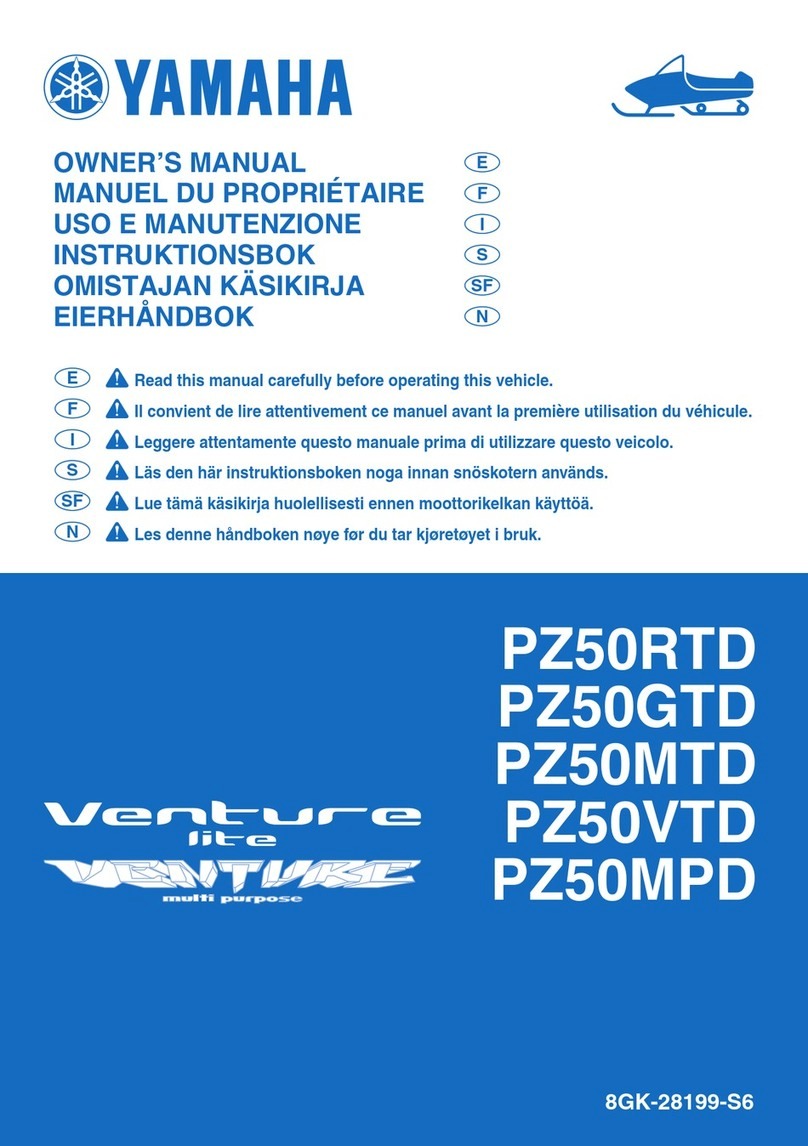
Yamaha
Yamaha PZ50RTD owner's manual

Club Car
Club Car 2005 FE290 Maintenance service supplement
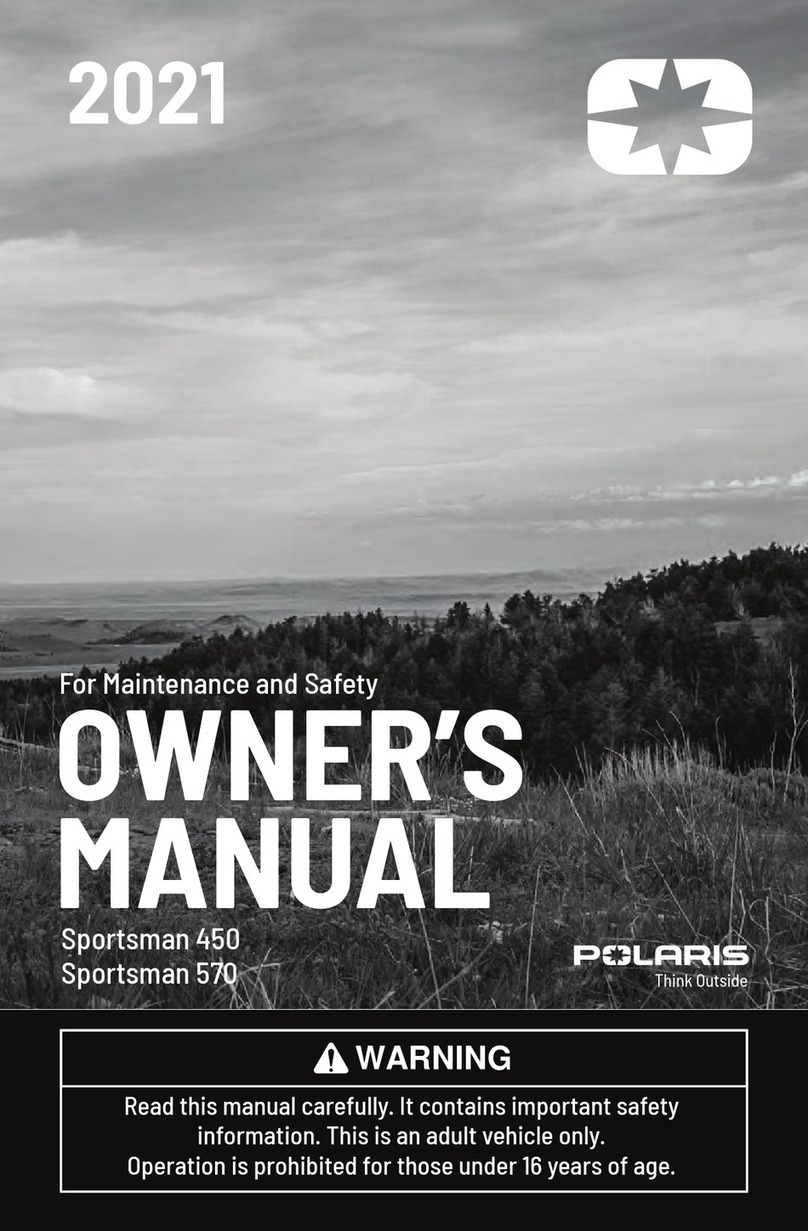
Polaris
Polaris Sportsman 450 2021 owner's manual
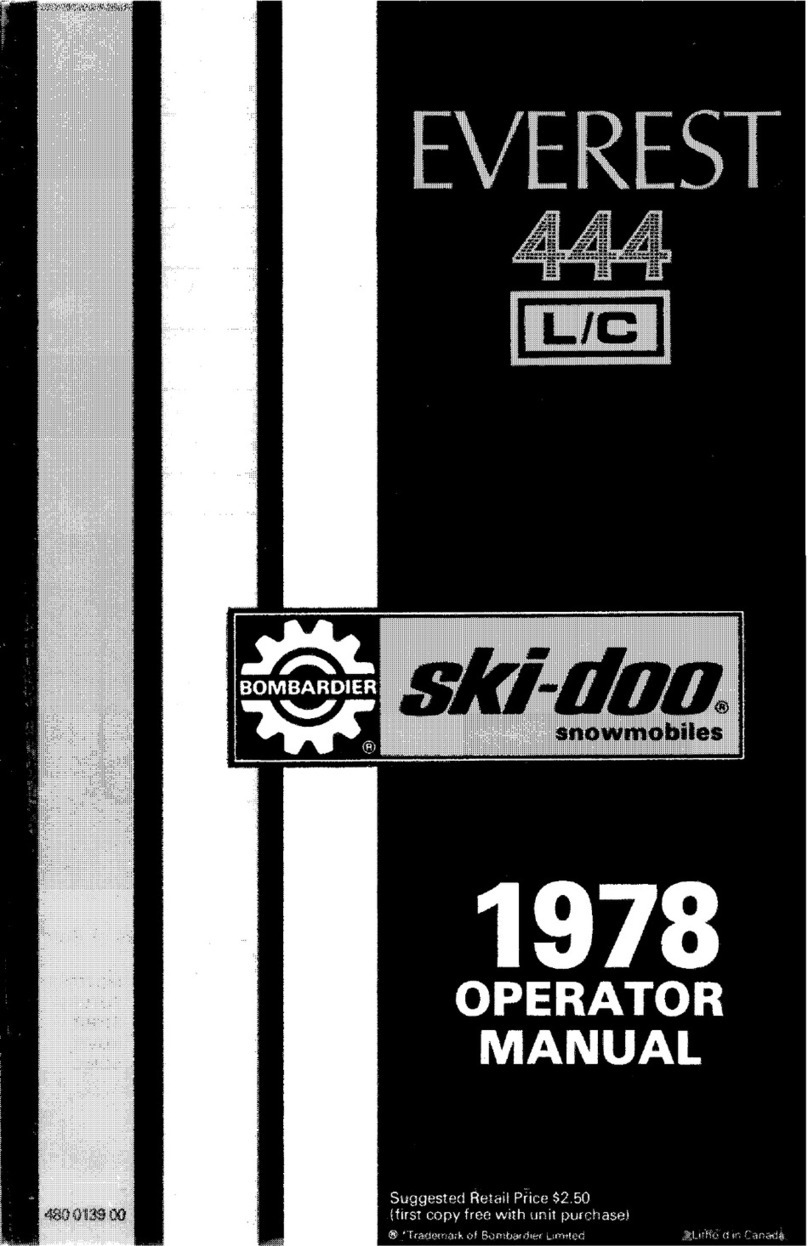
BOMBARDIER
BOMBARDIER ski-doo EVEREST 444 L/C 1978 Operator's manual
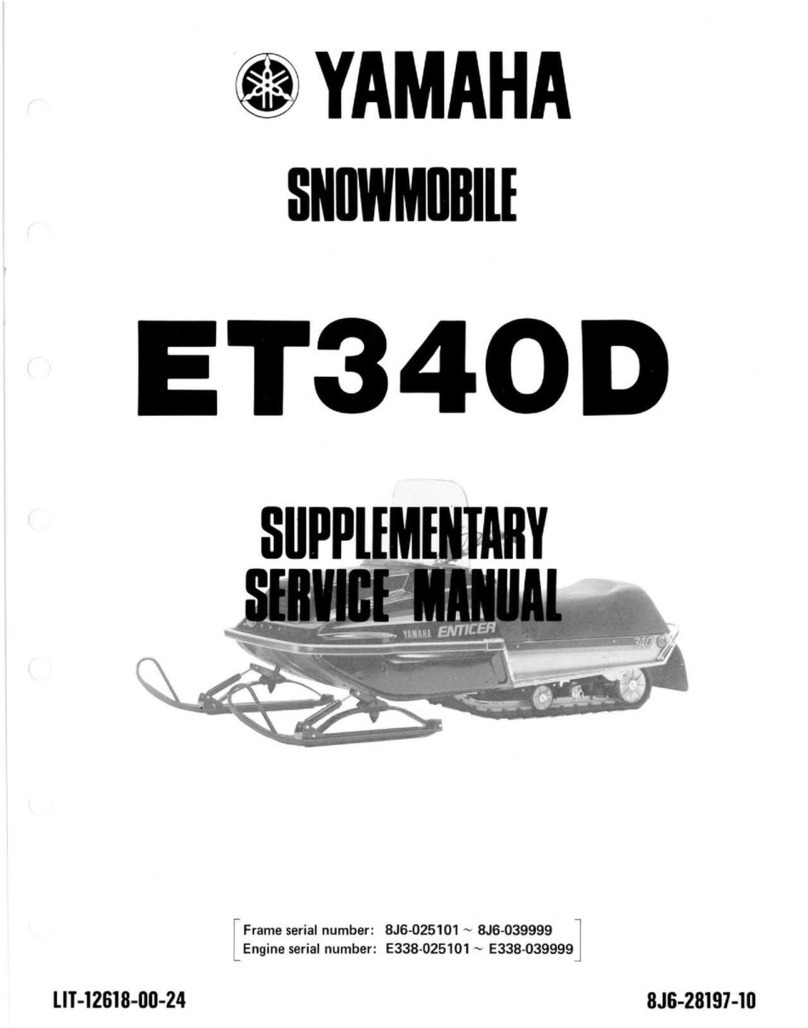
Yamaha
Yamaha ET340D Supplementary service manual

Arctic Cat
Arctic Cat M 9000 King Cat Operator's manual





